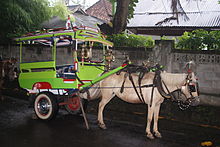
A Cidomo is a small horse-drawn carriage used in the Lesser Sunda Islands of Lombok and the Gili Islands of Indonesia.
Etymology
The name Cidomo is derived from the Sasak word cika or cikar (a traditional handcart), dokar (Balinese for pony cart) and mobil (Indonesian for car) for the wheels used to move it. It is also known as benhur after similarities to the Roman carts in the film Ben-Hur and Lombok "Ferrari".
Description
The carriage is usually brightly colored and often has many tassels and bells and pneumatic tyres. The carriage usually seats up to four people, two people in the front and two in the back. In the Gili Islands is one of the most common forms of transport as motor vehicles are not allowed.
Problems
One problem of the cidomo is that they are very slow and are partly responsible for creating traffic congestion in the towns. Dung from the horses is also posing an environmental problem in the towns and cidomo drivers have been urged by the Indonesian government to clean up after themselves or face suspension. Many tourists are against the inhumane way the horses are treated, often having to work long hours on concrete floors, visible signs of dehydration and sometimes suffering beating from the riders.
References
- ^ Steer-Guérard, Lisa; Berkmoes, Ryan Ver (15 March 2005). Bali and Lombok. Lonely Planet. p. 355. ISBN 978-1-74059-681-7. Retrieved 18 February 2011.
- Soebroto, Chris (2004). Indonesia OK!!: the guide with a gentle twist. Galangpress Group. p. 131. ISBN 978-979-9341-79-2. Retrieved 18 February 2011.
- Reader, Lesley; Ridout, Lucy (29 October 2002). The rough guide to Bali & Lombok. Rough Guides. p. 39. ISBN 978-1-85828-902-1. Retrieved 18 February 2011.
- Witton, Patrick; Elliott, Mark; Greenway, Paul (15 November 2003). Indonesia. Lonely Planet. p. 578. ISBN 978-1-74059-154-6. Retrieved 18 February 2011.
- Müller, Kal (1997). East of Bali: from Lombok to Timor. Tuttle Publishing. p. 49. ISBN 978-962-593-178-4. Retrieved 18 February 2011.
- "Drivers told clean or face suspension". Jakarta Post. 1 March 2010. Retrieved 18 January 2011.
This article about transport in Indonesia is a stub. You can help Misplaced Pages by expanding it. |